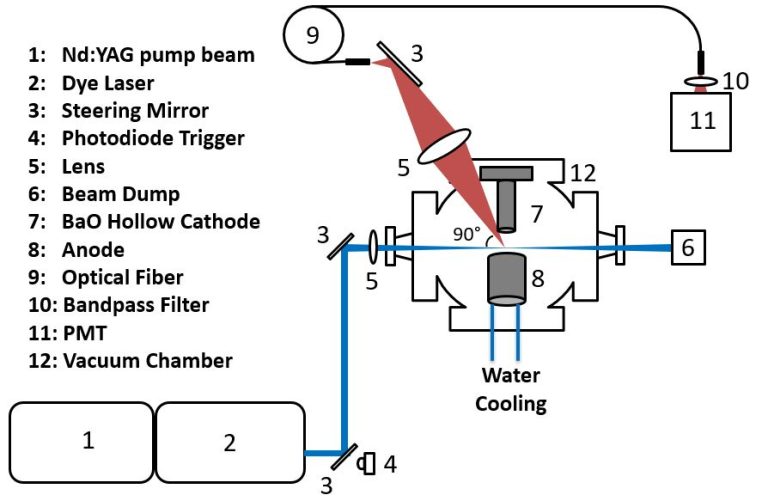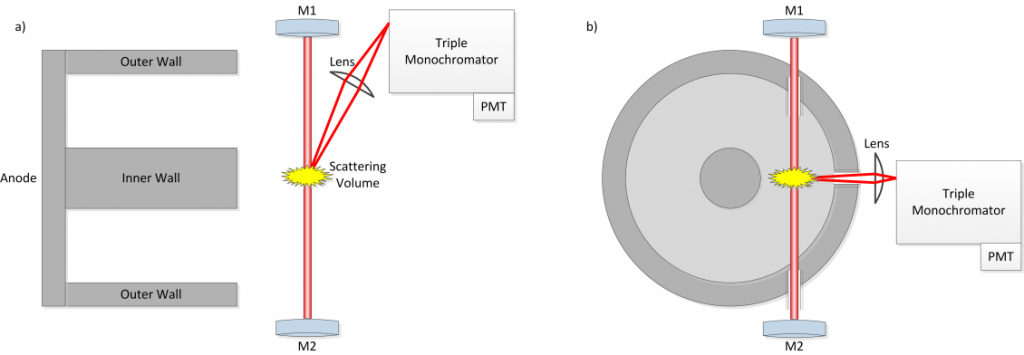Our Research
Our research focuses on laser-based measurement of gases, plasmas, and plasma-surface interactions for plasma science and electric propulsion applications. Interests also include laser ignition of engines, laser combustion diagnostics, high-power fiber delivery, and laser sensing for environmental and health applications.
Pre-Ionization Controlled Laser Plasma Formation
Laser based ionization sources have proven to have many benefits over conventional techniques such as spark plugs and igniters. However, plasma properties and associated ignition characteristics are largely uncontrollable. We are investigating the separation of the two stages of laser plasma formation (multiphoton ionization and electron avalanche ionization) by using two temporally resolved lasers operating at different wavelengths. By separating the ionization processes in this manner, we are able to access a wider range of plasma properties that were previously inaccessible. We then employ several diagnostic techniques such as Rayleigh and Thomson scattering to make 1-D measurements of the electron density and gas temperatures.

TALIF of Neutral Krypton in a Hollow Cathode and Hall Thruster Plasma
Neutral particle dynamics in the plume of a Hall Effect thruster play an important role in the device’s performance and lifetime. In particular, charge exchange reactions (CEX) between neutral particles and ions lead to sputtering of the thruster walls. CEX occurs more frequently in vacuum facilities where the pressures remain higher than that of space. To account for facility effects during lifetime tests, the density of neutral particles must be known. We are using Two-Photon Absorption Laser Induced Fluorescence (TALIF) to perform these measurements.

Cavity Enhanced Thomson Scattering
Interest in Hall thruster technology has continued to grow with emphasis on the development of high-power long life thrusters and improved understanding of plasma characteristics. Electrons play a key role in these devices; however available electron diagnostics are limited. To aid in the development of physics-based plasma models, improved capabilities for measuring electron number density (ne) and the electron energy distribution function (EEDF) are needed. Our group is developing Cavity Enhanced Thomson Scattering (CETS) to perform these measurements.

Cavity Ring-Down Spectroscopy of a BaO Hollow Cathode
We are performing in situ Cavity Ring-Down Spectroscopy (CRDS) to measure Ba density in a BaO hollow cathode. The measurement includes both Ba neutrals and ions and will help validate existing plasma models of the cathode. Additionally, quantification of the Ba density will provide a more fundamental understanding of the erosion product transport and will inform future design and operation of BaO cathodes to meet the demanding requirements for future deep space missions.

Mobile Open-Path CRDS for Atmospheric Methane Measurement
The background concentration of atmospheric methane has been steadily rising over the past decade. Anthropogenic sources such as agriculture and the oil and gas industry account for 60% of methane emissions into Earth’s atmosphere. Our project works on the development of a mobile methane sensor that uses open-path cavity ring-down spectroscopy in order to accurately measure methane plumes caused by anthropogenic sources.

Aerosol Characterization with Laser-Induced Breakdown Spectroscopy
The occupational health hazards associated with the inhalation of large airborne particles (20+ μm in diameter) are primarily determined by the chemical constituents of the particle. Elemental composition analysis can be performed in real time with laser-induced breakdown spectroscopy (LIBS), a process that involves sample ablation within a plasma generated by a high power laser pulse and inspection of the resulting emission spectrum.

Characterization Of High-Voltage Laser-Triggered Switches with Laser Thomson Scattering
The field of pulsed power research aims to generate conditions found within stars under controlled laboratory settings through high-power electrical pulses. The high power density conditions allow for the validation of high energy density physics simulations and provide an avenue for sustainable nuclear fusion. As new electrical switches are designed to achieve new pulsed power experiments, advanced diagnostics must be developed to quantify the energy loss mechanisms present within high-density transient plasmas.

Mobile Sensing of Ozone and Benzene Emissions with Deep UV Laser Lamp
Ozone and Benzene are vital chemicals for a variety of industries. High concentrations of benzene and surface-level ozone can have adverse effects on human health and must have their levels controlled. Highly sensitive measurements of these emissions can be obtained by using laser absorption spectroscopy (LAS) enhanced by use of a cavity and deep UV laser lamp. The condensed experiment set-up is capable of mobile sensing for a variety of applications, including examination of different highly emissive locations.
